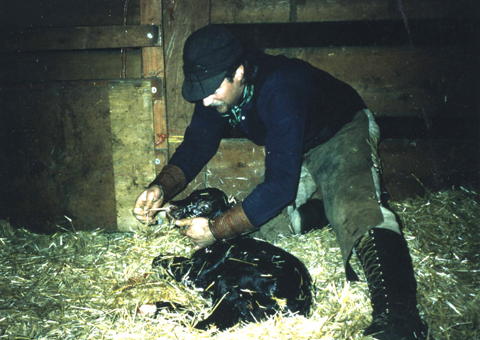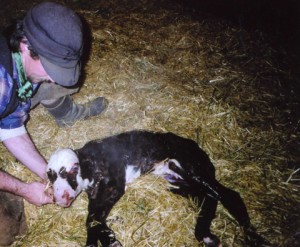
 Today’s guest blog is by Heather Smith Thomas who has written here before about Dealing with cold stress In cattle.
Today’s guest blog is by Heather Smith Thomas who has written here before about Dealing with cold stress In cattle.
This article originally appeared in New Mexico Stockman magazine.
In a normal, unassisted birth, the calf is stimulated to start breathing as soon as his umbilical cord breaks (since that’s his lifeline from the dam) and/or his face and nose are uncovered when the amnion sac comes off his head. There are several causes for breathing failure in a newborn calf. These include the sac not breaking, a hard birth in which the calf has become exhausted or unconscious from too much pressure for too long in the birth canal, and the placenta detaching too soon.
Some calves are born with the amnion sac intact, often with fluid still in it. If it does not break, and membrane or fluids remain over the calf’s nostrils, he won’t take a breath. This immersion reflex keeps him from drawing fluid into his lungs, but also means that some calves die soon after birth—unless the cow gets up immediately and starts licking it off and nudging the calf to get him moving and breathing. If the calf goes too long without oxygen, he will suffocate.
The sac often remains intact in a quick, easy birth. If the membranes are thin and easily broken, the calf can lift or shake his head and the sac breaks. If the membranes are thick, however, the calf can’t break them by himself. The cow’s instinct is to get up and lick her calf as soon as he’s born, which generally resolves the problem. But if she’s tired from labor, or a first calf heifer, she may not get up quickly enough. Most of the birth losses due to failure of the sac to break are in first calvers—such as an easy birth in which the calf slides out quickly, still encased, and the heifer may not realize she has a new baby and does not get up immediately.
Another common cause for breathing failure is a hard birth. The calf’s nose and tongue may be swollen and his airways constricted by swelling. The calf may also be unconscious if the cord was pinched off or broken before he was fully born, and he is short on oxygen. The placenta may start to detach too soon, if the cow took a long time getting the calf into proper position for birth (or can’t get him in proper position, such as a breech calf) or the delivery takes too long.
In most normal births, the calf begins breathing within 30 to 60 seconds after he’s born. If he’s not breathing, clear the fluid away from his nose with your fingers and tickle the inside of one nostril with a clean piece of hay or straw. This usually makes him cough and take a breath. If he’s unconscious and won’t start breathing, give artificial respiration.
Traditionally, compromised calves (not breathing, with fluid in their airways) were held up by their hind legs to allow fluid to drain from the airways, but now many veterinarians don’t recommend this. They’ll tell you that most of the fluids that drain from an upside-down calf are stomach fluids, important to health. Holding him up by the hind legs also puts pressure on his diaphragm from abdominal organs, interfering with normal breathing movements. It’s better to use a suction bulb to clear the airways.
If a calf was stressed during birth and doesn’t begin breathing immediately, it may be because he is suffering from acidosis—a pH imbalance in his body caused by stress and shortage of oxygen during birth—which has an adverse effect on proper functioning of heart and lungs. It may take several hours or several days for his body to correct this. One way to tell if he’s normal or compromised, according to Dr. Ron Skinner (a vet and seedstock producer near Drummond, Montana) is whether he tries to raise his head and become upright rather than continuing to lie flat. If the calf just lies there and has not tried to raise his head within 2 minutes, prop him up and rub him briskly to stimulate circulation. He can breathe better if he’s upright. Lung function and ribcage movement are impeded when he’s lying flat.
HOW YOU PULL A CALF MAKES A DIFFERENCE
If you have to pull a calf, it’s best if the cow/heifer is lying down. She can strain more effectively, and gravity is not working against you. When she’s down, you only need to pull about half as hard as when she’s standing, and this means less pressure on the calf. If she doesn’t lie down on her own once you’ve corrected a malpresentation problem, put her down on the ground using a rope.
Tie the rope loosely around her neck in a non-slip knot then use the long end to make a half hitch around her girth (behind her shoulders) and another around her flanks, with the remainder of the rope out behind her. Pull on that rope to tighten the half hitches, and the pressure will cause her to go down. This is much easier on her than trying to pull her hind legs out from under her. “If she goes down and jumps right back up, just take your time and pull on the rope again, and soon she’ll collapse without a big fight,” says Skinner.
When pulling a calf, always pull when the cow is straining, and rest when she rests. Do not put steady traction on the calf without this periodic let-up (one reason it’s best to pull by hand rather than with a calf puller). It takes time for the cervix to dilate and the birth canal to stretch to fullest capacity. “A cow doesn’t just squirt a calf out in 2 minutes when having a normal birth. She’ll get up and down, and push, and rest. The calf makes a little progress as she strains, then goes back in a little. The cow keeps stretching a little more, gets up and walks around and lies back down. So you can take your time when pulling the calf, and if you only pull as the cow pushes, you don’t have to pull as hard to get as much done. When she’s not pushing, let the calf back,” says Skinner.
If you pull constantly, there is constant pressure on the calf, impairing his blood circulation. “This is one reason some calves are unconscious and fail to start breathing when born. If he’s really tight in the birth canal (and you can feel his elbows pop when they enter the birth canal because it’s so tight), and you are constantly pulling on his legs that are tight against his head, his legs are putting pressure against his jugular veins. When I have a tight one like that, I’ll pull when the cow pushes, 4 or 5 times, and then I’ll push the calf back, to let him get some circulation to his head. After giving the cow a little time to rest, with the calf pushed back inside a bit (just like she’d be doing out in the field when she gets up and walks around a little), I’ll pull him out again. Once his head is out of the vulva to his eyebrows, then you can go ahead and finish pulling him. You can then get him out with a few more pulls because the cow is now stretched enough for him to come—and when he gets out he will usually breathe,” explains Skinner.
“What happens with most of the calves that don’t start breathing after birth (even though they still have a heartbeat) is that we’ve impaired the circulation to their heads too long. One of the things that stimulates the calf to breathe is the dropping level of oxygen in the bloodstream (when the umbilical cord breaks and he no longer has a constant supply of oxygen), and this triggers the brain to tell the calf to breathe. But if we’ve been pulling the calf with constant pressure, we’ve cut the circulation off to the brain enough that this trigger isn’t happening; we’ve made him brain dead and this is why he won’t breathe,” says Skinner.
If you consistently allow a calf some periodic relief from pressure as you are pulling him, you’ll rarely have a calf that won’t breathe when he is finally delivered. This may take a little longer, but it’s safer. You don’t tear the cow’s vagina or put the calf at risk. He does not have to breathe until the umbilical cord is squeezed off, and this won’t happen until he is nearly fully born—unless he’s coming backward.
“I’ve seen a lot of old-timers restrain a heifer in a slot in the barn, stick a pole behind her, and use a come-along to pull the calf—hooked to the gate across the alley. Even if they hooked it as low as they could, to the bottom of the gate, the angle wasn’t quite right, and the poor heifer would be hanging over the pole, and the pressure was never let off. They killed a lot of calves that would not have died if they’d been pulled properly,” he says.
Sometime when a calf is coming through the birth canal he makes it partway through and then hangs up at the hips or stifles on the cow’s pelvic bones. If it’s a hiplock, the calf’s hip bones will be caught on the pelvis, and the calf is only about halfway out—and his ribcage will not yet be free of the birth canal and it will be impossible for him to start breathing.
“The calf is just out past his shoulders. He has to come out farther before he can breathe. By contrast, with a stifle lock, the calf is farther along when he hangs up on the cow’s pelvis and his chest will be out of the birth canal,” says Skinner. In these instances, the ribcage can expand and the calf can start breathing, which gives you a lot more time to resolve the problem.
 “You don’t need to get excited. Get him breathing, then take your time, and make a plan on things you are going to try. Take time to put more lubricant around the calf, then try to work him out of there.”
“You don’t need to get excited. Get him breathing, then take your time, and make a plan on things you are going to try. Take time to put more lubricant around the calf, then try to work him out of there.”
The time you need to hurry is when you see the placenta starting to come out ahead of the calf. If the placenta is detaching prematurely, the calf will lose his “lifeline” and will die before he’s born. This is when it pays to pull the calf immediately, and you can often save the calf.
The other time to hustle is in the last stages of a backward delivery, since the calf’s head is still in the uterus when his umbilical cord is being pinched off. Pull slowly and give the cow plenty of time to stretch as his hind legs rump are coming through the cervix; pulling too fast at this stage may injure the cow or the calf (hurting his back or crushing his ribcage as it starts through the pelvis). But once his rump is emerging from the vulva you have to get him out of there as quickly as possible because the umbilical cord is being broken or pinched off and he will have to start breathing.
GIVING ARTIFICIAL RESPIRATION
If the calf’s heart is still beating, he’s still alive and there’s hope to get him breathing. In a limp, unconscious calf the heart may be hammering so loudly you can hear it, as the body struggles to survive without oxygen. If he doesn’t start breathing soon, however, the heartbeat becomes weaker, slower and very faint. Heart rate is one way to tell if the calf is in respiratory distress, since it drops as the body is deprived of oxygen. Normal heart rate in a newborn calf is 100 to 120 beats per minute. Place your hand over the lower left side of the ribcage, just behind and above the elbow of his front leg. If heart rate has dropped as low as 40, the calf’s condition is critical; he needs to start breathing immediately. Color of his gums will also be a clue; if they are gray, blue, or colorless instead of pink, he is in serious trouble.
To get him breathing, first clear the airways. Roll him onto his breastbone in an upright position with chin resting on the ground and nose as low as possible; this position allows fluid to drain from his nostrils. If necessary, use your fingers to strip fluid from his mouth and nose in a suction-like action, like squeezing a tube of toothpaste—or use a suction bulb if you have one in your pocket. Rub and massage the calf, moving his legs, to help stimulate lung action.
If he won’t take a breath even after tickling his nostril, you’ll have to blow air into his lungs. Lay the calf on his side with head and neck extended. Cover one nostril tightly with your hand, holding his mouth shut (to prevent air escaping) and gently blow a full breath into the other nostril, forcing air into the windpipe and lungs. Don’t blow rapidly or forcefully or you might rupture a lung. Blow until you see the chest rise. Then let the air come back out. Blow in another breath until the chest rises again. Continue filling the lungs and letting them empty, until the calf starts breathing on his own. Usually, once the body tissues become less starved for oxygen, the heart rate will rise, the calf will regain consciousness, and start to breathe.
___________________________________________________________________________________________
Heather is a really interesting woman who writes articles for many horse and livestock publications and has written 20 books, most of them about horse and cattle care management. You can see some of her work at Storey Publishing by clicking HERE.
One of her other publishers, Oak Tree Press, published her book Beyond the Flames; A Family Touched by Fire which she wrote after her daughter’s severe burn injuries 11 years ago, and how it affected their family and totally changed their lives. You can order the book by clicking HERE.
She also has an interesting blog, telling about her family and her experiences, including her ranching lifestyle and what’s been happening since that incident. That blog is HERE and I look forward to her entries.
